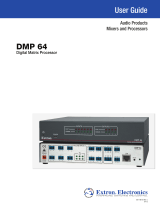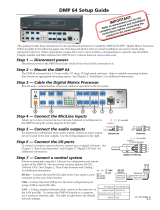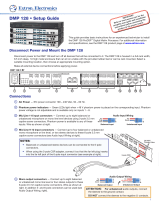
DMP 64 Plus • Contents v
Output Trim Block .......................................... 59
Output Delay Block ........................................ 60
Output Filter Block ......................................... 60
Output Dynamics Block ................................. 60
Output Attenuation Block............................... 60
Aux Outputs ...................................................... 61
Naming an Aux Output .................................. 61
Aux Output Processing ...................................... 62
Aux Output Trim Block ................................... 62
Aux Output Filter Block .................................. 62
Aux Output Dynamics Block .......................... 62
Aux Output Gain Block .................................. 62
Expansion Outputs ............................................ 63
Naming an Expansion Output ........................ 63
Expansion Output Processing ............................ 64
Expansion Output Trim Block ......................... 64
Expansion Output Delay Block ....................... 64
Expansion Output Filter Block ........................ 64
Expansion Output Dynamics Block ................ 64
Expansion Output Attenuation Block ............. 64
Virtual Send Bus ................................................ 65
Configuration Tools ................................... 67
Presets .............................................................. 67
Methods for Marking Items ............................ 68
Configuring Presets ....................................... 68
Groups .............................................................. 69
Configuring Groups ....................................... 70
Digital I/O ......................................................... 72
Configuring Digital I/O .................................... 73
Players .............................................................. 75
Configuring Players ........................................ 76
Macros .............................................................. 78
Configuring a Macro ...................................... 79
Configure USB Audio......................................... 82
Selecting USB Audio Channel
Configuration ................................................ 82
Creating and Assigning USB Input Audio
Control Groups ............................................. 83
Creating USB Input Audio Control Groups ..... 83
Configure Internal Triggers ................................. 84
Configuring an Internal Trigger ....................... 84
Deleting an Internal Trigger............................. 84
Testing a Trigger ............................................ 84
Pushing Internal Triggers to a Host Device ..... 85
Device Manager ................................................ 85
Managing Devices in Device Manager ............ 86
Connect to or Disconnect from Device .............. 87
Firmware Loader ............................................... 88
Downloading Firmware Updates .................... 88
Organize Building Blocks ................................... 91
Device Settings.................................................. 92
Unit Info ......................................................... 92
IP Settings .................................................... 93
Passwords .................................................... 93
Serial Settings ............................................... 94
Date/Time .................................................... 94
USB Audio ..................................................... 95
Dante Device ................................................ 97
Options ............................................................. 98
Expansion Bus .................................................. 98
Connecting the EXP Ports ............................. 98
Phone Dialer .................................................... 101
Placing a Call with the Phone Dialer ............. 102
Receiving a Call with the Phone Dialer ......... 102
Audio Control Panels (ACP) ....................103
ACP Panel Types ............................................. 103
Panel ID # ........................................................ 104
ACP Panel Button Control Types ..................... 104
Fixed ........................................................... 104
Follow Selector ............................................ 105
Selector-Vol/Mute (Selector) ......................... 105
Button Labels .............................................. 105
Using Multiple ACP Panels .............................. 105
Configuration Examples ................................... 105
ACP 100 Configuration Example .................. 106
ACP 106 Style Configuration Example ......... 108
Saving and Pushing ACP Configurations ..... 111
Dante Controller ......................................112
Overview ......................................................... 112
Downloading and Installing Dante Controller .... 113
Configuring the DMP 64 Plus in
Dante Controller ............................................. 113
Device Name ............................................... 113
Receiver and Transmitter Names ................. 114
Dante Controller Naming Conventions ......... 114
Renaming the DMP 64 Plus in
Dante Controller ......................................... 114
Renaming a Receiver or Transmitter............. 116
Finding a Dante Device IP Address .............. 118
Physical Dante Network Setup ........................ 119
Redundant Configuration ............................. 119
Dante Controller Operation .............................. 121
Dante Transmitters and Receivers ................ 121


























